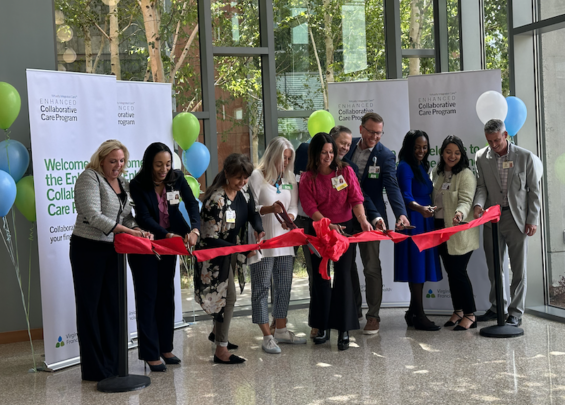Virginia Mason Franciscan Health Care offers virtual nursing solution

The value of virtual health care was a huge lesson that came out of the COVID pandemic. Another was learning how to pivot, especially amid nursing shortages and career burnout.
For Virginia Mason Franciscan Health (VMFH), those lessons converged with the creation of the first acute virtual care nursing program on the West Coast. The Enhanced Collaborative Care Program launched at St. Anthony Hospital in Gig Harbor in May and at St. Anne Hospital in Burien in October.
“The workforce shortage helped us realize that if there is a silver lining in the COVID pandemic cloud, we could find one through innovation, technology and collaboration,” VMFH Senior Vice President and Chief Nursing Officer and EDB Board member Dianne Aroh said. “But we had to be open to new approaches and willing to abandon the way things had been done before.”
Not an ‘either-or’ world
One such approach was to talk directly with the people in the know. “If you want to find solutions amid a nursing shortage, nurses are the best people to talk to,” Aroh said.
The VMFH team learned that hospital nurses want to stay in the workforce, but they also want more autonomy and control, along with more flexibility with their schedule for a better work-life balance. Many are burned out, and many are caring for children or aging parents.
From those conversations, a virtually integrated nursing care model was created that bolsters patient care and enables nurses to work from VMFH hospital offices or from home. Enhanced care nurses don’t replace bedside nurses who are physically present on a hospital unit, but rather work alongside their onsite team members as part of a patient’s care team.
“This is not an either-or proposition,” Aroh said. “You can still be a hospital nurse, and you don’t always have to be physically present.” Nurses may opt to work both onsite and virtual shifts, which can give them both flexibility and the opportunity to recharge between physical shifts.
Patients also have options. Not everyone is comfortable seeing a nurse via a computer monitor in their hospital room.
Big response, rave reviews
Ahead of the pilot rollout at St. Anthony, Aroh received 350 applications for 31 open enhanced care nurse positions. The jobs attracted people who had become traveling nurses, and nurses who quit to move out of the area who could now work remotely. The model also drew another vital segment – retirees.
Retired nurses who left the profession because of the physical demands of working in a hospital unit have found that the virtual model enables them to stay on the job. And they’re also lending their knowledge to train a new generation of enhanced care nurses, something else that can happen virtually. That’s a big win in the health care workforce realm. Research shows that younger RNs are leaving the profession at a high rate.
Transforming care together
Key to the program’s success was VMFH’s decision to sidestep a top-down strategy and partner with frontline team members throughout the design and implementation process. Along with nurses, other stakeholders involved from the start included physicians, patients, and representatives from employer labor relations and finance.
That inclusivity and preparation have paid off. Enhanced care nurses at St. Anthony and St. Anne have not only embraced the new virtual care model, but they’ve also become the program’s biggest ambassadors.
“They’re sharing their positive experience with others,” Aroh said. “There’s no better recruitment tool than that.”
VMFH expects to implement the Enhanced Collaborative Care Program at four or five more hospitals by the end of the first quarter of 2024. The program will eventually expand to the health system’s remaining hospitals in the state.